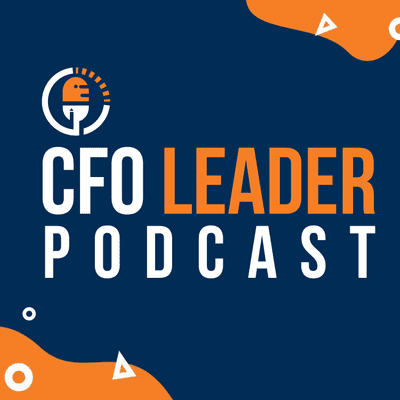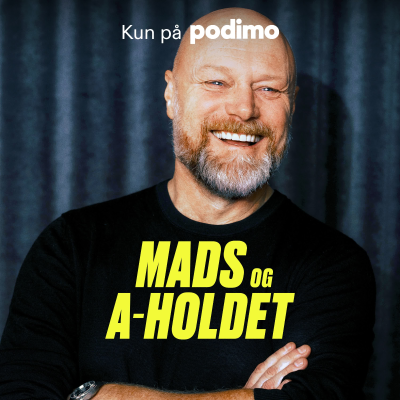
CFO Leader
engelsk
Business
3 måneder kun 9 kr. Derefter 99 kr. / måned. Ingen binding.
Læs mere CFO Leader
The CFO Leader podcast is focused on providing tactical tools to finance executives from experienced leaders who have been in the trenches. With a primary focus on practical rather than theoretical, CFO Leader is your go-to for the modern finance executive.
Alle episoder
8 episoderLive Panel - When Vision Meets Reality: Managing an Operating Plan
In this special edition episode of CFO Leader, we record a live expert panel of CFO's discussing the ins and outs of managing an operating plan. We cover three main areas of discussion: Part 1: Operating Plan Foundation (15 minutes) * Planning * Preparation: * What is the role of the CFO vs other executives in the operating plan process? (Kevin McKenzie) * How do you evaluate the effectiveness of your prior year’s operating plan? (Elliot Smith) * Relationship between the Operating Plan, Forecast and Fundraise Strategy (Ray Langhaim) * How to determine the appropriate amount of complexity for your operating plan? (Kevin McKenzie) * What is the timeline for your Operating Plan Timing, from Start to Board Approval? (Elliot Smith) * Rolling Forecast vs a Fixed Plan? Why choose one or another? (Ray Langhaim) * Architecture * Bottom-Up vs. Top Down operating plan architecture. Why choose one over the other? (Kevin McKenzie) * Macro vs Micro - What is the appropriate amount of detail for the operating plan? (Elliot Smith) * Securing Approval/Reviewing * How do you move from department budgetary wants to needs? (Ray Langhaim) * How should the CFO think about Identifying/Communicating Risks to the executive team/board as pertains to the plan? (Kevin McKenzie) Part 2: Managing the Operating Plan (15 min) * Once you have a board-approved plan, Now what? (Elliot Smith) * Processes to manage/keep up with the plan? * Critical items to be monitoring? * How should the CFO deal and communicate assumption errors & other variances (Ray Langhaim) * How to deal with unexpected changes in the operating plan? (Kevin McKenzie) * How should the CFO deal with underperforming departments? (Elliot Smith) * How to manage executives that aren’t bought into the operating plan? (Ray Langhaim) * Scenarios * We Exceed the plan (Kevin McKenzie) * What to look out for? * When to formally adjust the operating plan? * Problems that unexpected revenue growth creates Part 3: The Wartime CFO - Managing a company turnaround (15 min) * Talk about mentality change between peacetime CFO and Wartime CFO (Elliot Smith) * How do you think/act differently? * What processes procedures do you put in place? * Managing the board and executives during Wartime, what are best practices (Ray Langhaim) * Cutting Budgets/Headcount * Setting up decision frameworks for action: & making the hard calls : (Kevin McKenzie) * Cutting Budget * Canceling initiatives * Layoffs * Tips for taking the emotion out of the decision (Elliot Smith)
Ken Kaufman - Scaling a remote finance team
Episode Content Outline * General Discussion * Building a Remote Finance Team * Ken to give overview of structure of current team * Ken to talk through closing calendar structure * How do you manage your close calendar? * What are the critical monthly deadlines? * When are the books closed? * The Virtual Assistant to the CFO * How do you currently leverage a virtual assistant(VA)? * Their duties/responsibilities? * Gaining trust with a new VA * When should a CFO hire a VA? * Effective communication with your VA * Finding a VA * Project Manager * What is the purpose/role of the PM * Structure * Onshore vs Offshore * Which roles are better suited for Offshore/onshore? * Issues to consider when choosing whether to find onshore/offshore remote talent. * Recruiting * Onshore * How do you interview for remote finance hires? * What do you look for in a remote candidate? * What are the warning signs that a candidate isn’t suited for remote work? * What working hours expectations do you set with your teams? Especially offshore or people who are in different time zones? * What do you recommend for equipment policy for your onshore hires? * Offshore * Where to look when searching for Offshore help? * Websites? * Tips for interviewing/etc. * Paying Offshore contractors/tax issues? * Using an agency vs direct contractor hire * Using part-time contractors? * Onboarding/Training * Once you have hired people, what advice would you give regarding the onboarding and training process in a 100% remote environment? * Maintaining Culture and Morale * How do you build and maintain relationships with a 100% remote team? * What do you do for team building, etc? * How do you gauge if an employee is at risk of leaving or is having an issue with engagement? * Is there an expectation to have the onshore team at the same place together at some interval (once or twice a year?) * Summary: * Advice for those building a team from scratch * Advice for those who are transitioning from a local team to a remote team * Running a Remote Finance Team * What is your meeting cadence with your team and how often do you touch base? * Dealing with time zone differences * How do you keep on top of your team? * How do you know if deliverables are being worked on, and your team is running efficiently? * What tools do you use to run your team? * Task Management? * Communication? * Document/workpaper storage? * Monthly Accounting Calendar? * Any other considerations? * Wrap Up * What are your top “Do” and “Do not” regarding managing a remote finance team? * Do * Do Not
Wade Olsen - Just exactly what IS treasury? Pt. 1 - Cash Visibility
Definition- What is Treasury? * What areas of responsibility typically fall under treasury? * The most liquid parts of the balance sheet initially and over time, the entire balance sheet * Cash management, investments, debt/leverage, working capital, bank relationship management, receipts/payments processing, credit & collections, foreign exchange, hedging (commodities and/or currencies), risk management / insurance, employee stock programs, investor relations * When should a company consider hiring dedicated treasury talent? * Depends on complexity treasury responsibilities / needs (debt, foreign exchange, payments, receipts, etc) * Companies typically look at hiring treasury talent when they reach revenues >$500 million and/or they expand internationally * What are the fundamentals of Treasury * Cash Visibility and Reporting * Cash forecasting and capital planning * Who are the players in your forecast who will put inputs into your forecast? * Receivables * Payables * Capital Planning, such as CapEx and financings * Distributions/dividends to shareholders based on their expectations for cash * Debt Providers, including their covenant requirements * How much detail do I need in my forecast? * Balance between time required to gather, validate and input the data with reconciliation and other needs for details * Best practice is to at a minimum define your main inflow and outflow buckets needed to align with company goals/reporting and forecast to that level * Also segregate by entity and/or region depending on how your company is organized * Identify and work with consistent providers of information * How to build a usable forecast? * Define and seek information on a set schedule (weekly, monthly, quarterly) * Identify forecasting participants and get their and their supervisor’s buy in, if possible include a metric in their annual employee review to their forecasting abilities * AP - Payments supervisor or delegate * AR - Credit and Collections supervisor or delegate * Payroll - HR supervisor or delegate * CapEx - FP&A/controller * Debt / Investments - treasury * Other - as needed * Communicate consistently and regularly with forecasting participants via email and/or other communication avenues within the forecasting tool you use * Build forecast using desired tool: Google Sheets, Excel (best when on a shared server), or a TMS * For Google Sheets and Excel: * Create templates for each forecasting participant with rows showing input and columns for dates (increments of daily, weekly, monthly or quarterly) * Keep the templates separate and restrict access to the person responsible and the person compiling the forecast. * Be mindful when building template’s structure that participants will likely be pulling information from ERP systems and from items on their desk and in their emails; build the templates accordingly. * Place the templates on a shared drive and or email them out a few days/weeks before each cycle depending on what participants’ need. * Before kicking off a forecasting program, schedule training time with each person individually and walk through their input template and seek feedback on how to improve the template but be careful not to make it too flexible and thus unmanageable. Also clearly outline timing, level of detail needed, and ways for them to communicate any non-standard information (notes field on template, email, ect). * Run a test forecast process soliciting information via email or desired communication from each participant. * The consolidated report for each forecast cycle will typically be a unique workbook with a separate tab/sheet for: * Consolidated report page (this is what gets published if you publish tabular information) * Graphing and analytics (also gets published) * Build trending graphs using key lines off the consolidated report. Include referential data like last year data for the same period on the graph. * Each input template * Historical information * When building the consolidated report page, reference key ROWS on the input templates and the historical data and/or run pivot reports off these sheets to the build consolidated report. Keep these ROWS consistent each forecasting period so you don’t have to modify your spreadsheets too much. * Run the first forecast and then repeat on desired schedule. * Continually update historical data into your forecasting spreadsheet and categorize it the way the categories are in your forecast. * Build an accuracy measuring tool to check your forecasts’ accuracy versus historical data on each increment in time (daily, weekly, monthly, quarterly) and by each input category (AP, AR, Payroll, etc). This will help you identify weak areas (time increments and/or categories) and increase accuracy over time. Run the accuracy measure ahead of each forecasting cycle and share with the forecasting team. * Make sure to date/time stamp each input template so you can inventory each forecasted period’s inputs just in case you have to go back to research anything - can be easily done in a field on the template and/or within the file name (i.e. YYMMDD - Forecast Payroll) * TMS systems do a lot of these things for you but some are costly and difficult to use. There are options that can meet most any budget however (happy to expand on how Treasury Suite and our competitors approach forecasting if we have time, but likely not). * What tools do you use? * I’ve used Excel extensively, most companies do. Google Sheets is great for sharing but not as powerful. I’ve also designed and used TMS forecasting tools. Their complex and oftentimes difficult for infrequent users of the tool. * What does a good cash forecast look like? * Consistent, repeatable, categories of cash flows that align with business / operating needs, simple graphing and tables (too much complexity people won’t use it), clear color and layout, name at the bottom so people know who’s responsible if they have questions. * How should we be thinking about Treasury by stage and what is the key indicator that you have moved to a different stage * Startup - Focus on: * Cash visibility that at a minimum that shows all banks and all account balances on a daily basis, transaction detail is nice too * Include any debt (revolving, term, leasing) that shows outstanding, available, and repayment schedules (include in forecasting) * Efficient, effective and timely payments and receipts. Leverage electronic payments and receipts as much as possible (reduced fraud and cost typically). * Restrict access to cash/investment/debt information to only those that need it. Use tools at banks * Mid - Focus on: * Cash visibility showing all banks and all account balances on a daily basis and include transaction detail as well * Include any investments (where located, balances, purchase/redemptions, accrued interest, etc) and compliance to investment policy and comparison to benchmarks * Include any debt (revolving, term, leasing) that shows outstanding, available, and repayment schedules (include in forecasting) * Efficient, effective and timely payments and receipts * Add additional monthly metrics / reporting such as: * DSO, DPO and CCC * Payments processed per person/time period * AR / AP aging reports and top 5 main focus customers/vendor for each * Enterprise - Focus on: * Same as above but expand on the amount of detail available in each, likely need to provide metrics for public disclosures as well * Develop a monthly treasury operations report that outlines all the items noted above and gets updated in real time and published monthly * Staff Development * Since you don’t have a dedicated treasury function, how do you train your staff and allocate responsibilities. * How to train staff and yourself to better execute treasury functions. * Join local, regional and national treasury organizations (the main one is the Association for Financial Professionals), attend their regular conferences/meetings and leverage their online educational opportunities * Network with other treasury talent at local finance conferences/meetings put on by AFP, your banks, auditors, and other financial providers * Earn and maintain the Certified Treasury Professional (CTP) certification from AFP * Lean vs Flush Treasury, how should your thought processes and approach to treasury change as CFO. * Lean Scenario * Focus on Fundamentals - see start up as outlined above * Cash visibility that at a minimum that shows all banks and all account balances on a daily basis, transaction detail is nice too * Include any debt (revolving, term, leasing) that shows outstanding, available, and repayment schedules (include in forecasting) * Efficient, effective and timely payments and receipts * Focus on fraud prevention * Flush Scenario - see Enterprise as outlined above * More flexibility due to expanded resources but need to focus on being efficient and fraud controls * More robust treasury systems and tools are available, but make sure they are user friendly or their just a waste of money and time. * Wrap Up * What are your top “Do” and “Do not” regarding treasury management? * Do * Focus on visibility and maximizing your liquidity resources * Don’t leave cash latent in accounts, paydown debt and/or transfer to an investment * Current FDIC deposit insurance rate and other bank fees are typically not being offset by the earnings credit rate (ECR) that your bank offers, instead, move that cash out to paydown debt and/or invest it * Develop strong relationships with your banking, debt and investment providers - expand those relationships whenever possible * Constantly review and intermittently test your fraud prevention / risk management tools and processes * Review your bank relationship and fees at least annually, maybe even semi-annually * Benchmark your treasury operations regularly with others in treasury, from joining the AFP (local and national) and from attending events * Do Not * Become complacent * Let your guard down when it comes to fraud prevention * Expect to have it all in place at once, it takes time to build, measure, and enhance treasury processes, especially when you add complexity from growth into new markets and create new risks/challenges/opportunities
Carl Seidman - Your Financial Models Suck
Carl Seidman, of Seidman Financial discusses how CFOs can architect and construct better financial models. We also chat about tips to becoming a better reviewer of financial models prepared by others. Conversation to focus around three areas: i. You are responsible for the creation of a financial model of some sort for your company that will involve inputs from several departments. What are best practices to go from “Carl we need you to model this out” to a completed, published model? ● Carl: “Where people can often go wrong is they see the creation and management of the financial model as the goal. But instead, they should be viewing the financial model as a way to facilitate conversations and better decision-making. I often see companies where finance is in control of the model as well as the planning and forecasting process, but this traditional approach brings about inefficiency in planning, a fractured system of accountability, and a poorer buy-in from non-financial groups. In contrast, finance should not be responsible for the planning process – only the financial planning elements of the process – at least in the beginning phases. As finance people, we’re not best suited to understand the intricacies outside of our function – the departments heads are. Instead, department leaders should each be responsible for their own planning but with direct coordination and collaboration with finance which may ultimately manage the model. Once ‘modeled out’, finance can further inquire and nudge other departments and become deeper entrenched in ops. ● Companies are often surprised by my approach to financial modeling and planning in that I spend a lot of time upfront conducting diligence, drafting and plan, and building a process even before I start modeling. How often does a financial modeler say “you know, I built this model months ago, and if I’d known we’d be moving in this direction today, I would’ve built this model differently.” The goal is to never have to say that. To do your research and planning upfront, build a flexible dynamic model, so that it can grow and evolve with the company rather than retire and replace it every few iterations. ii. You have just started a new position as CFO of a company. Your head of FP&A hands you a financial forecast model that he has prepared. How should a CFO approach the review of a model that they may or may not be intimately familiar with and get to a point of reasonable confidence that the model is working as intended? ● I constantly remind (humorously) the groups and companies I work with that their models are going to be wrong. It takes some of the seriousness and aspiration for perfection away from the mandate. But that light-heartedness and attitude doesn’t mean that we don’t take modeling and forecasting very seriously. Forecast models are used by almost all mid-sized and large organizations for very important decisions. But those decisions aren’t just based off of precision – they’re based off of data, expectations, predictions, guesses, and most importantly…assumptions. We can make conjectures about the future and be reasonably correct and fairly accurate, while knowing our actual numbers will be incorrect. This is the mindset a CFO should adopt. Rather than obsess about accuracy, obsess about assumptions and the related confidence and risk. ● Model integrity comes in two forms: One, mechanics; and two, intelligence. Mechanics is all about the quality of the model build, from layout, to formulas, to easy of use, data importing, and synthesis. A model without strong mechanics is inefficient. But a model without intelligence is worthless. You can have a model that’s clunky but contemplates the right intelligence and it can be leveraged. Whereas if you have a model that’s laid out perfectly, has all the bells and whistles, but doesn’t represent reasonable economic assumptions, it’s worse than useless – it’s dangerous. ● If we’re going to get to a point of reasonable confidence, we need to test the model to see if it gives us the outputs we would expect to see when we push it. As smart finance people, we can often perform back of the napkin calculations quickly and we can vet those assumptions with the refined analysis that the model can provide. iii. In your mind, what are some general model best practices and landmines that you have seen in model design and preparation? ● Best Practices - A point I raise to all of my clients and groups is: a model is never yours and it’s not built for you. In FP&A, sometimes our models are MANAGED by us, but they’re almost always built for the benefit of others. If you’re going to build a model, don’t do so in the same way and style you’ve always done it and expect others to come around to you. Ask what it’s going to be used for, who it’s going to be used by, what are future uses? How does the model need to be built to support this? ● I’m typically very finicky about laying my models out in such a way that even the most unfamiliar modelers can make sense of it. An advanced modeler shouldn’t need to spend an hour understanding how it’s built, how it’s managed, and where drivers connect. It should be intuitive and sometimes it’s harder to make something clean and intuitive than complicated and self-serving. ● I typically try to use summaries and graphs to illustrate points rather than financial outputs that take time to more deeply analyze. I tend to use various font colors to bring attention to inputs/drivers vs. outputs/formulas. ● If I’m using Excel or Google Sheets, I tend to add in dynamic functionality which allows my models to grow with minimal or no formula updating. ● Landmines – Some of the biggest landmines in modeling (at least in Excel and Google Sheets) is making the model too complex unnecessarily by using bad practices. Bad practices that cause the most problems are having too many links, too many manual processes, and too much data importing/updating. ● To be most specific, I’d caution people to avoid linking cells across multiple worksheets, forming physical links that are easily breakable, or using approaches that require hours of work to update and are easily exposed to errors. ● I’ve worked with Fortune 500 companies that run multi-billion dollar books of business from Excel models and the models are so clunky because of these bad practices. Again, it should be as simple, clean, and flexible as possible. You don’t need to be a super advanced modeler to be able to do this, but sometimes you have to be advanced to be able to think so simply. iv. If I myself want to become a better modeler, or invest in my team to become better modelers, what do you recommend? ● I’ve worked with and have even had people work for me who are Excel gurus. They know the platform inside and out and know so much they can even teach me new features I don’t know. Where did they learn so much? YouTube. Or from inexpensive video training programs. There’s nothing at all wrong with this and I encourage anyone to get more and more familiar with the platforms they use. ● Many good Excel or financial modeling trainings are taught by either software/data people, ibankers or professors. Many are super sharp, and particularly within Wall Street Prep, where I have an affiliation, there are some of the brightest, sharpest ibankers and PE folks. ● But there’s a big challenge in this FP&A and corporate finance space. Being a guru in Excel doesn’t mean you understand finance. And having an ibanking background doesn’t mean you have a grasp of FP&A or what it takes to be a good CFO. If you find a strong FP&A person, chances are they spent many years at one company or a small handful of companies and may not have seen FP&A outside of that limited context. So you don’t get different perspectives. Even when I speak to Directors of FP&A at Fortune 500 companies, they sometimes admit they don’t know what they don’t know. ● I took note of this major gap when I built my FP&A development curriculum years ago, which I’ve since delivered to thousands of FP&A professionals at some of the most recognizable companies. A successful financial modeler isn’t just someone who understands Excel or Google Sheets, he or she is a very well-rounded person who can understand many elements of finance, business, industry, leadership, and operation among other things. It’s almost as though they’re a junior CFO. ● If you want to become a better modeler, find a good, reputable training program that doesn’t just address the mechanics but addresses real life application – ideally taught by someone who has a rich background doing what you want to learn. ● And just one final point, do know that financial modeling isn’t specific to Excel and Google Sheets. While these spreadsheet platforms are perhaps most common for small and mid-sized companies, there are lots of very good EPM planning platforms quickly making their way downstream. They integrate seamlessly with Excel and GS and are economical.
David Bedell - Managing a Board of Directors
David Bedell, CFO of HireVue chats with me about thoughts and considerations when interacting and managing your relationship with the board of directors, including discussions on reasons why CFOs get fired by the board. We divide our discussion into two parts. First, we talk about items to consider when evaluating the board of directors at a company you are considering joining as CFO. What are the dynamics to consider with different board structures? Second, we chat about thought processes around managing your relationship with the board. How should you communicate with the board? What will get you fired as CFO from a company? What are the top Dos and don'ts when managing the board? How to be intentional about your relationship with the board.
Vælg dit abonnement
Begrænset tilbud
Premium
20 timers lydbøger
Podcasts kun på Podimo
Gratis podcasts
Ingen binding
3 måneder kun 9 kr.
Derefter 99 kr. / måned
Premium Plus
100 timers lydbøger
Podcasts kun på Podimo
Gratis podcasts
Ingen binding
Prøv gratis i 7 dage
Derefter 129 kr. / måned
3 måneder kun 9 kr. Derefter 99 kr. / måned. Ingen binding.

































